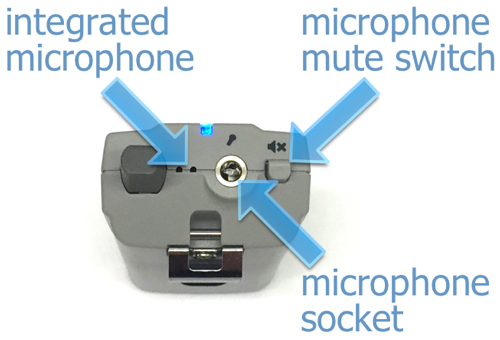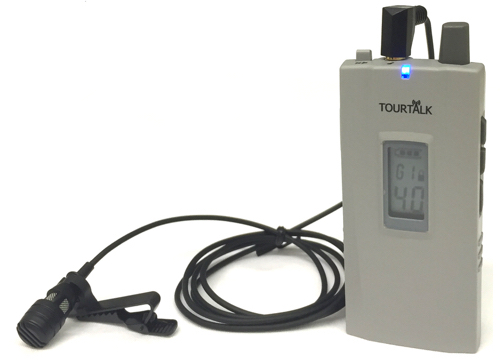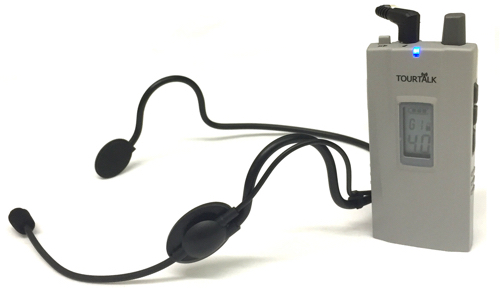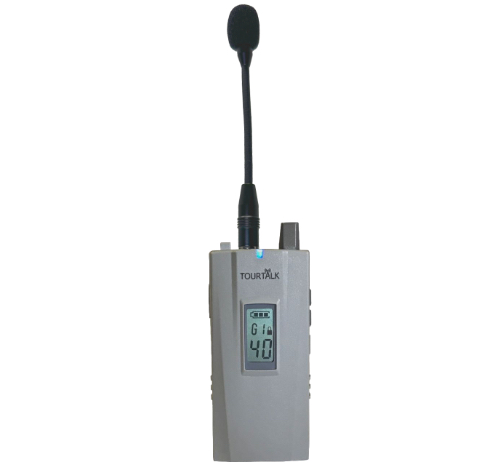A tour guide system is a portable wireless communication system that allows a guide to speak to a group of people. A system consists of a transmitter with a microphone for the guide, receivers with headphones for the audience, and (often) a charger storage case.
To get the best results from your tour guide system it is important that the most suitable microphone is used. If you get a poor-quality audio signal into the system then you can only get a poor quality audio signal out of it. i.e. if the correct microphone is not used then the audience members will not hear the system at its best possible quality.

A wide range of microphones is available for tour guide systems for different applications and environments. The most common types are-
Lapel microphone

This microphone is plugged into the mic socket on the top of the transmitter and is clipped to clothing on the guide’s chest. The microphone should be placed directly under the chin facing the mouth.
Tip. It is important to fit the microphone centrally so when the guide looks and turns their head while speaking, the input to the microphone remains consistent. The microphone should also be isolated from any jewellery, zips or lanyards, as these will cause noise if contact is made.
Lapel microphones are ideal for indoor tours in quiet areas.
Headband microphone

This microphone is also plugged into the mic socket on the top of the transmitter and is worn on the head. The microphone frame is worn around the back of the guide’s head and placed on the ears. An adjustable microphone boom is then suspended in front of the mouth. These microphones are very lightweight and comfortable to wear for long tours.
As the microphone is also placed in close proximity to the guide’s mouth, it provides very consistent sound and reduces the amount of extraneous background noise. This microphone is ideal for tours in noisy areas (so the guide doesn’t have to shout), and quiet areas (so the guide can whisper). It can be used indoors and outdoors.
As the microphone is securely worn around the head it can be used for active tours such as rambling, horse riding, cycling and Segway tours.
Plug-in microphone

This microphone is plugged directly into the mic socket on the transmitter and is used when a tour has multiple guides taking part. This directional microphone is designed to reject background noise and must be used by facing it towards the mouth of the presenter.
This microphone is ideal for when a presentation is conducted by multiple guides, as it can be quickly and easily passed between people. It is also ideal for any interviews or audience participation during the tour.
Integrated microphone
The transmitter has an integrated microphone built-in on the top. The integrated microphone can be useful as a back-up should the external microphone become damaged or lost during a tour.
This microphone is muted when an external microphone is connected to the mic socket.
Tip. To get the best results from the integrated microphone it should be placed close to the mouth when speaking.
With all the different tour guide microphone options above, the microphone can be muted at any time by pressing the button on the top of the transmitter. The blue LED will flash to indicate that the microphone is muted.
Tip. It is important to mute the microphone if the guide needs to discuss anything confidential during the tour. It is easy to forget that the wireless transmitter has a range of up to 120m. Your guests may not be able to hear your natural voice but will however hear every word, even if you are in a different room!
Please note. The mute switch does not mute the aux socket.
If you have any questions about which microphone would be most suitable for your application then please do not hesitate to contact us.
Reference documents can be downloaded below-
Tourtalk TT 100 tour guide system
Tourtalk TT 40 tour guide system
